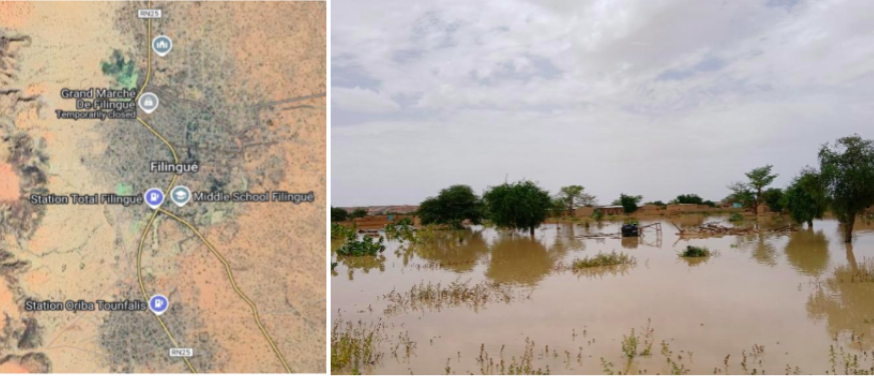
Niger, located in the Sahel region, is particularly vulnerable to natural disasters such as floods, droughts and sandstorms. These events are exacerbated by climate change, which increases the frequency and intensity of extreme weather events .
The torrential rains that fell across the entire territory of Niger in October 2024 caused catastrophic floods, seriously affecting all regions of the country. According to the latest data from the Directorate of Preparedness, Alert and Disaster Management, the floods caused the collapse of more than 73,500 houses, left more than 710,000 people homeless, and caused the death of 273 people. Beyond the human losses, more than 2,757 huts, 6,208 walls, 120 classrooms, and 858 sheds were destroyed. The losses also included 1,920 granaries, 823 shops and 21,145 tons of food, highly affecting the livelihoods of the inhabitants. In terms of livestock, nearly 18,000 heads perished, worsening an already critical situation for communities depending on livestock.
The second semester of 2024 was marked by heavy rainfalls which caused flooding in several localities of Niger including the city of Filingué, home to 456,328 inhabitants and located approximately 160 km northeast of Niamey, the capital of the country and 200 km east of Tillabéri. Field data from municipal authorities showed a loss of more than 1,900 households, or more than 13,000 disaster-affected people in the town of Filingué.
Field data from the municipal authorities showed a loss of more than 1,900 affected households, or more than 13,000 affected in the town of Filingué. Remote sensing mapping shows that the floods began in August and peaked in October, particularly affecting mud houses spread over 10 km2.

Using the notebook on determining the seasonal extent of water bodies with Sentinel-2 through the DE Africa sandbox, Cheffou Rachid used the Normalized Difference Water Index (MNDWI) as a proxy for water presence. The time series shows that flooding started around the beginning of August 2024 and reached a maximum level from October 09.
Statistics show that the town of Filingué remained arid from January to July. Torrential rains began in August and approximately 9.94 km2 were flooded, causing human and material damage.

The use of open and free geospatial technologies, and especially Digital Earth Africa platforms with a long time series, allows researchers, governments and humanitarians to monitor floods in order to optimize interventions. By combining field data with earth observations, Rachid has provided an overview of the extent of flooded areas and the material damage caused. The results of this study suggest that it is necessary to develop agglomerations in areas with low or no flood risks and to improve construction materials because mud houses are the most affected.
About the author:
 Cheffou Rachid is a hydrogeological engineer specializing in geospatial technology and water resources and is currently undertaking his doctoral thesis. He participated in the implementation of research projects in the field of water resources and agriculture in connection with remote sensing and GIS.
Cheffou Rachid is a hydrogeological engineer specializing in geospatial technology and water resources and is currently undertaking his doctoral thesis. He participated in the implementation of research projects in the field of water resources and agriculture in connection with remote sensing and GIS.
He is the promoter of the company HYGEO specializing in the promotion and services related to geospatial technologies in Niger.